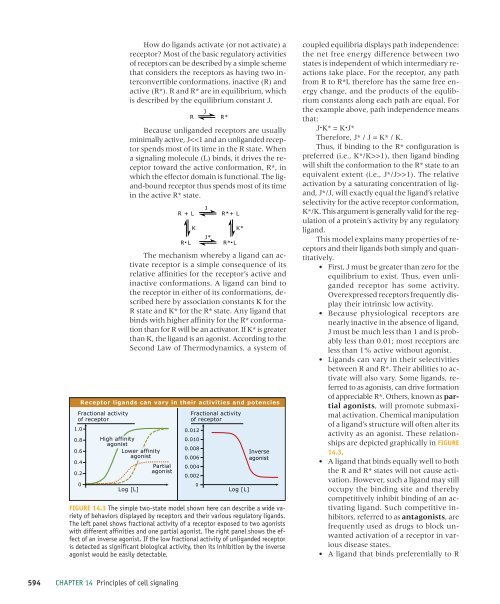Principles of cell signaling - UT Southwestern
Principles of cell signaling - UT Southwestern
Principles of cell signaling - UT Southwestern
Create successful ePaper yourself
Turn your PDF publications into a flip-book with our unique Google optimized e-Paper software.
39057_ch14_<strong>cell</strong>bio.qxd 8/28/06 5:11 PM Page 594<br />
How do ligands activate (or not activate) a<br />
receptor? Most <strong>of</strong> the basic regulatory activities<br />
<strong>of</strong> receptors can be described by a simple scheme<br />
that considers the receptors as having two interconvertible<br />
conformations, inactive (R) and<br />
active (R*). R and R* are in equilibrium, which<br />
is described by the equilibrium constant J.<br />
Because unliganded receptors are usually<br />
minimally active, J1), then ligand binding<br />
will shift the conformation to the R* state to an<br />
equivalent extent (i.e., J*/J>>1). The relative<br />
activation by a saturating concentration <strong>of</strong> ligand,<br />
J*/J, will exactly equal the ligand’s relative<br />
selectivity for the active receptor conformation,<br />
K*/K. This argument is generally valid for the regulation<br />
<strong>of</strong> a protein’s activity by any regulatory<br />
ligand.<br />
This model explains many properties <strong>of</strong> receptors<br />
and their ligands both simply and quantitatively.<br />
• First, J must be greater than zero for the<br />
equilibrium to exist. Thus, even unliganded<br />
receptor has some activity.<br />
Overexpressed receptors frequently display<br />
their intrinsic low activity.<br />
• Because physiological receptors are<br />
nearly inactive in the absence <strong>of</strong> ligand,<br />
J must be much less than 1 and is probably<br />
less than 0.01; most receptors are<br />
less than 1% active without agonist.<br />
• Ligands can vary in their selectivities<br />
between R and R*. Their abilities to activate<br />
will also vary. Some ligands, referred<br />
to as agonists, can drive formation<br />
<strong>of</strong> appreciable R*. Others, known as partial<br />
agonists, will promote submaximal<br />
activation. Chemical manipulation<br />
<strong>of</strong> a ligand’s structure will <strong>of</strong>ten alter its<br />
activity as an agonist. These relationships<br />
are depicted graphically in FIGURE<br />
14.3.<br />
• A ligand that binds equally well to both<br />
the R and R* states will not cause activation.<br />
However, such a ligand may still<br />
occupy the binding site and thereby<br />
competitively inhibit binding <strong>of</strong> an activating<br />
ligand. Such competitive inhibitors,<br />
referred to as antagonists, are<br />
frequently used as drugs to block unwanted<br />
activation <strong>of</strong> a receptor in various<br />
disease states.<br />
• A ligand that binds preferentially to R<br />
594 CHAPTER 14 <strong>Principles</strong> <strong>of</strong> <strong>cell</strong> <strong>signaling</strong>
















